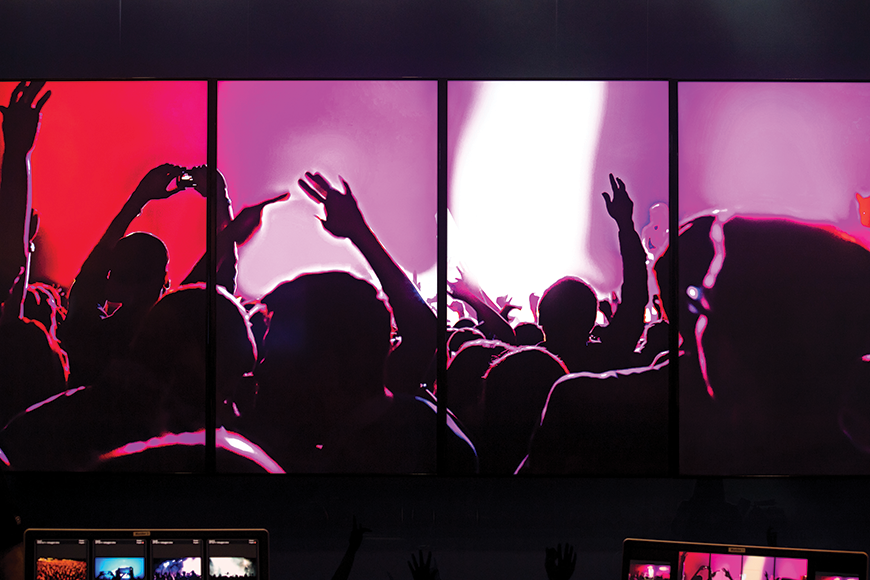Last September, when InfoComm International became the Audiovisual and Integrated Experience Association (AVIXA), I was approached by a sales manager for a successful AV integrator. He offered his congratulations and enthusiastic support for the move, but he cautioned me, in essence, that some traditional AV integrators didn’t have much expertise creating AV “experiences”—those spectacular events, shows, exhibits, public displays, etc.—that often come to mind when we talk about “experience design.” Conference spaces, classrooms and the like were their bread and butter.
I totally get it. And if you didn’t specialize in AV spectacles, you might have thought you were missing out on something, or that AVIXA was leaving you behind. But, as I said at the time, an integrated AV experience doesn’t have to be an event with a big budget, and all the bells and whistles. Those are often the most high-profile, eye-catching projects (and, admittedly, the ones we often feature when telling the industry’s story), but they represent just some of the integrated experiences that AV professionals create, and that AVIXA aims to promote.
An AV experience can certainly be a spectacular live event or an awe-inspiring museum exhibit. However, it can also be a well-designed huddle space or conference room, where the technology is intuitive and transparent, and where, in every meeting, all the participants—remote and local—can clearly see and hear each other, collaborate with digital information and have a productive meeting. That’s an integrated AV experience, delivered through well-designed and well-executed AV solutions. That’s what AVIXA believes is this industry’s value proposition.

In the context of AV, experience is the added value that trained AV professionals bring to a project. It’s the difference between a commodity AV system that a customer buys off the shelf—or, for example, from an IT vendor—and an installed AV system that takes into account more than just technology, so that the customer gets from the solution exactly what he or she wants…and more.
For several years now, we’ve been talking in terms of the “exceptional” AV experience…the right combination of content, space and technology needed to create the outcome, whether it’s entertainment, collaboration, communication or instruction, that a customer is seeking. AV professionals know to account for each component of such an experience. They’re among the first to weigh environmental factors—the acoustics and lighting in a space—and their effect on the AV experience. They know to consider whether a presentation is in the right aspect ratio, and whether a video stream is at a sufficient resolution and frame rate to have the right impact. And, they know which technology choices are sufficient to deliver the experience that the customer is after.
So, what is the experience your customer is after? That might take some exploration. The answer is rarely just “digital signage” or “a videoconference.” If it were, then customers really could do it themselves (and some will try). What they’re likely to overlook are the content and space considerations of the experience, and how that combination of elements will yield the right results.
To deliver the right AV experience, it’s important to find out what outcome the customer wants to achieve. AVIXA and the subject-matter experts who help inform our training have long maintained that a needs analysis is key to a successful project. It’s really the point at which you ask a ton of questions, covering everything from the system’s ultimate end users, to the room where the solution will be used, to the critical goals of the system—again, the experience that the customer wants the AV designer to create.
A needs analysis is important because, sometimes, it’s hard for the customer to anticipate—and put into words—what he or she wants a system to accomplish. AVIXA has been spending a lot of time lately with retail and hospitality stakeholders. One thing we’ve heard frequently—you’ve probably heard it, too—is that, for example, a company knew a spectacular videowall could have a positive effect on its business, but it hadn’t figured out how to keep the content fresh and engaging over the life of the system. That’s part of the experience, and it should be considered when engineering an integrated solution. If you ask customers upfront how they plan to generate content and what it will look like, the outcome should be a better experience (and maybe even lead to more business for you in the form of content services).
Can you measure an experience? There are certainly ways to evaluate how an AV solution is best experienced. AVIXA standards for AV systems performance, audio coverage and display image, plus more, help ensure the technology itself is integrated to have maximum effect. Beyond that, it’s important to try to measure the outcomes those AV experiences will generate in order to gauge the experiences themselves. This could also be part of the needs analysis.
In many cases, information will be important, so a networked AV solution that generates data is essential. Not to oversimplify, but, if your customer and you agree that a videoconferencing solution delivers the right experience when people use it a lot, then tracking utilization might be important. Some customers track how quickly their users can launch a videoconference (ever wasted 10 minutes at the start of a 30-minute virtual meeting wrangling the technology?).
For more experiential AV designs, users can employ surveys or follow social media metrics, like for events or public displays. In retail, the holy grail has been sensing who’s looking at a message, for how long, what their demographics are and whether the message leads to a meaningful conversion (sale).
Back when the AV industry was predominantly about selling products, all of this might have been the responsibility of customers’ operations teams. Because AV is now much more strategic—part of enterprise technology plans—the solution must take into account the entire experience.
The fact that AV is fundamental to how people experience the world is not new. The fact that customers can derive real value from those experiences is, however, a relatively fresh perspective, and one that will continue to drive industry growth for years.
